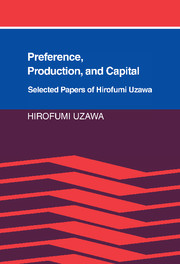Book contents
- Frontmatter
- Contents
- Foreword
- Preface
- I Preference and demand
- 1 Preference and rational choice in the theory of consumption
- 2 On the integrability of demand functions
- 3 Time preference, the consumption function, and optimum asset holdings
- II Duality and production
- III Concave programming
- IV Equilibrium and stability
- V Theory of economic growth
- VI Optimum growth
- Index
3 - Time preference, the consumption function, and optimum asset holdings
Published online by Cambridge University Press: 04 May 2010
- Frontmatter
- Contents
- Foreword
- Preface
- I Preference and demand
- 1 Preference and rational choice in the theory of consumption
- 2 On the integrability of demand functions
- 3 Time preference, the consumption function, and optimum asset holdings
- II Duality and production
- III Concave programming
- IV Equilibrium and stability
- V Theory of economic growth
- VI Optimum growth
- Index
Summary
Introduction
The problem of demand for money and other assets has been recently studied by Douglas (1966) and Sidrauski (1965) within the framework of a rational individual faced with the choice of a consumption schedule which is optimal with respect to the individual's time preference structure. In both papers, the intertemporal utility function upon which the consumer's choice is based is represented by a discounted integral of the stream of instantaneous utility levels, where future utilities are discounted by a rate which is kept constant independently of time profile of the utility stream associated with each consumption schedule. Thus, if a consumer is permitted to hold his assets either in the form of real cash balances or in the form of perpetuities yielding a constant rate of interest and if his instantaneous utility function is linear and homogeneous, he will either postpone his consumption until the very last moment or will consume as much as possible, according to whether the subject rate of discount is lower than the rate of interest. The only case in which the individual would desire to possess two types of assets simultaneously is one where his subject rate of discount is precisely equal to the rate of interest. Douglas has avoided this difficulty by having the level of bond holdings as one of the components for instantaneous utility level, while Sidrauski has introduced real capital as an alternative asset for which the rate of return varies with the amount held.
- Type
- Chapter
- Information
- Preference, Production and CapitalSelected Papers of Hirofumi Uzawa, pp. 65 - 84Publisher: Cambridge University PressPrint publication year: 1989
- 40
- Cited by



